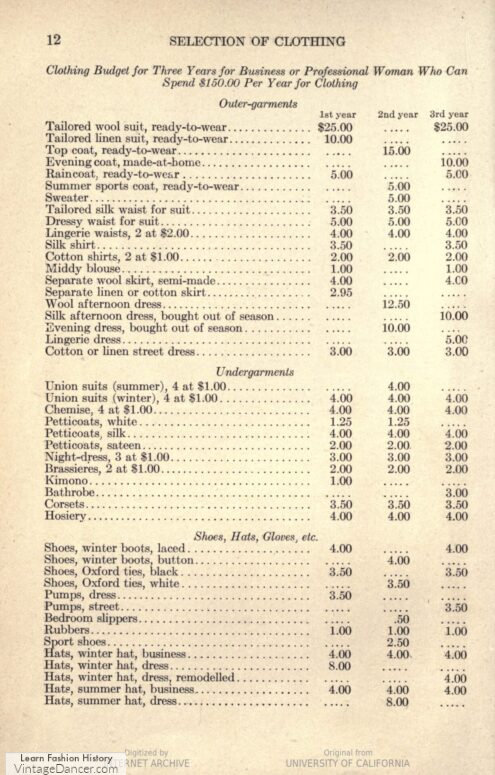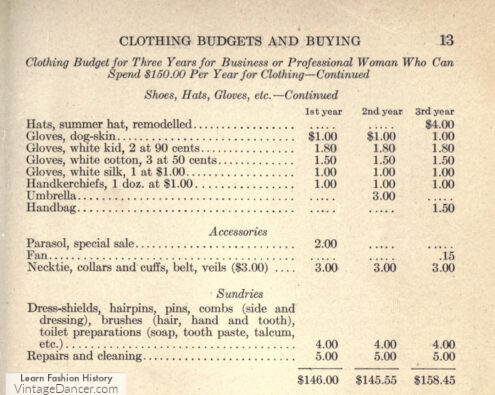
The number of clothing we have today is massive compared to the limited wardrobes from the 1910s. With smaller incomes, higher quality clothing, less variety of clothing, and more home sewing skills, the pre-fast fashion years were one of careful planning and dedication to wearing clothes out completely.
What was in a 1910s women’s and men’s wardrobe? How many clothes did men and women need to purchase every year? How did working classes vs city folk shop differently? What was the cost of clothing in the 1910s?
These are the types of questions I set out to answer using a few different resources: 1. American government surveys usually tied to a specific region or occupation. They tended to focus on the working classes – farmers, laborers, occasionally city dwellers, and 2. High school girls’ home-economics books. Girls were taught to budget, sew, purchase and repair clothing. They often included lists of clothing the typical student’s family needed.
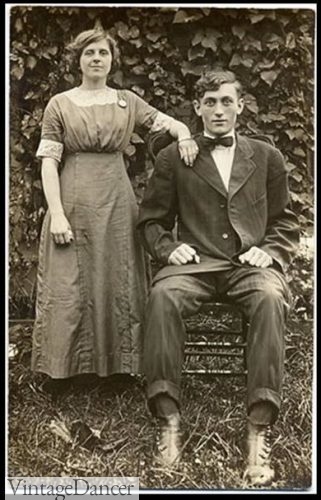
Average clothing for the middle classes
The difference between classes – working farmers vs. middle class city families – was surprisingly little. Time and time again I read about how more income only meant spending more on a clothing item, not necessarily buying more of them.
The exception was young, single women, who spent more on dresses, shoes and hats every year than any other age group. Upper classes also bought more variety of clothing, specialty clothing, and formal wear.
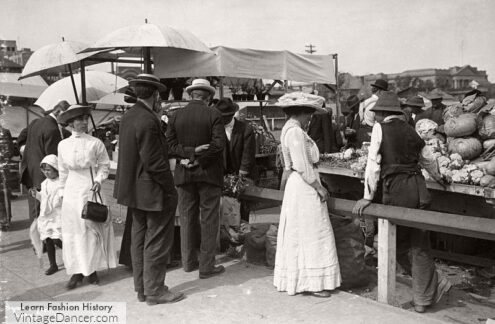
1910s shopping int he market
Working classes spent more time sewing and repairing clothing at home. Some women who knew how to knit made baby clothes, neckties, shawls, blankets, socks, underwear and occasionally sweaters.
Clothing was replaced only as needed, not because the fashion trends changed. Most major garments like dresses and suits were purchased every 2 years. Clothing was also repaired, cleaned or shaped (hats), which also took a bit of the clothing budget each year.
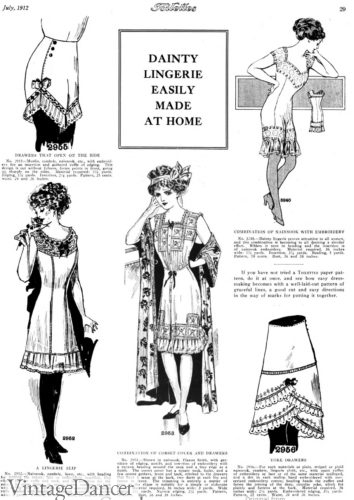
1912 underwear: Drawers
High-use items such as hosiery were purchased frequently throughout the year. Underwear, however, was not replaced as often as I expected. Men and women only had a few pairs in their drawer at a time, possibly re-wearing them several times before going to the wash. They were made significantly better and lasted longer than our underwear today, but still, I’m a little grossed-out.
Of the lists below, there are some items missing. Specialty sportswear was purchased by the classes that could afford it, but never made it to these lists. Certain styles of clothing such as a specific jacket or type of negligee might have been lumped into a general category.
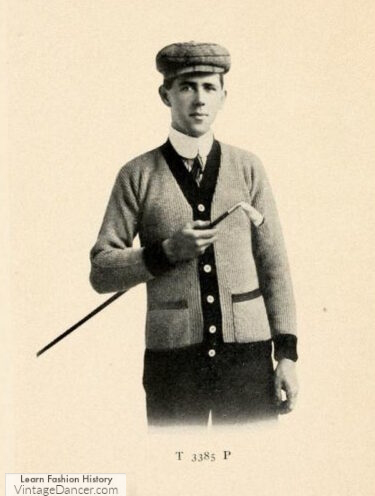
Sportswear such as this golf sweater was often left off clothing plans
Women’s lingerie, too, had so much variety and personal preference that the lists are generalized and not very specific. Clothing for special occasions such as travel, weddings, summer vacations, and school uniforms are also missing.
The final things to note about these lists is that most are compilations of clothing that were purchased each year (or every few years). A person certainly had more than these items in their wardrobe at any given time. Everything was worn until it was no longer usable.
For example, a man’s new hat was saved for special occasions and his old hat became his working hat. A woman’s old street dress became a house dress before it was eventually made into an apron or children’s clothing. Hats were re-trimmed. Shoes were re-soled and heels replaced several times a year. Many smaller items were never purchased because they were given as gifts at Christmas.
On to the 1910s Capsule wardrobe lists!
1910s Capsule Wardrobes
In 1917, Washington DC women spent about $125 to $200 per year on purchased (ready-to-wear or customer made) clothing. Working girls spent about 10% of their earnings on clothing. Working families spent 12-15%. Middle classes 12-20%. A laboring man spent a minimum $50 a year. A shop girl spent $75. A college girl between $97-250, and a fashionable wealthy woman spent $300-400.
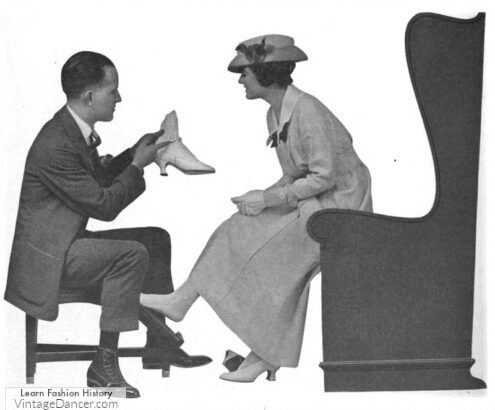
1916, shopping for new shoes
Women had the choice of going to a custom dress maker (who also repaired or upcycled old garments), buying ready-to-wear from a shop or second hand cart, or making clothing at home. The latter was the most economical, and produced simple but durable clothing.
Ready-to-wear cost only a little bit more than homemade and had more decoration, but was thin and faded quickly. It needed more frequent replacement but saved the owner time from home sewing and a higher expense for custom work.
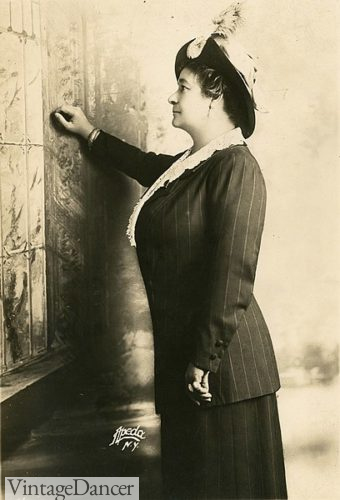
1913 Ernestine Schumann-Heink
During the first World War, women made do with less clothing. A typical woman owned 1 day dress, 1 suit, and 1 silk dress along with a uniform for a service job/volunteer work. A good suit was considered the most important purchase, but also one of the most expensive. Suits needed to last at least 2 years or more.
After the war, women and men were less likely to overspend on clothing, having learned to do without for several years.
First, let’s take a look at a 1917 city woman:
- Coats – 1 light coat or suit jacket, 1 heavy coat or wrap, 1 raincoat (replaced every 4 years). Purchased every 2-3 years.
- Tailored suit – 1 purchased every 2-3 years
- Sweaters – 1 purchased every 3-5 years
- Day dresses – 1 day gown and 3 cotton dresses or shirtwaist suits purchased every 2 years.
- Party dress – 1 purchased every 2 years.
- Blouses – 1 dressy blouse purchased every 2 years and 3-5 day blouses, purchased yearly.
- Wool skirts – 1 wool and 2 summer skirts, purchased every 2 years.
- Nightgown – 1 lasting a few years.
- Hats – 1 summer, 1 winter, purchased yearly.
- Shoes – 5 pairs a year, purchased or repaired as needed.
- Gloves – 4 purchased every 2 years.
- Stockings – 15 pairs, purchased yearly.
- Underwear – 2 corsets a year, purchased yearly.
- And accessories.
- 1916 wardrobe purchasing plan for $150 a year
- 1916 wardrobe purchasing plan for $150 a year
Here’s another woman in 1917 who made her own clothing spent money on fabric and notions:
- $10 for 2 dresses.
- $7 for 8 blouses.
- $2 for 2 skirts.
- $5 for 1 sweater.
- $8 for 3 hats.
- $2 for aprons.
- $5 underwear.
- $5 for misc (trim for hats, buttons, etc).
In total, she spent $87 a year.
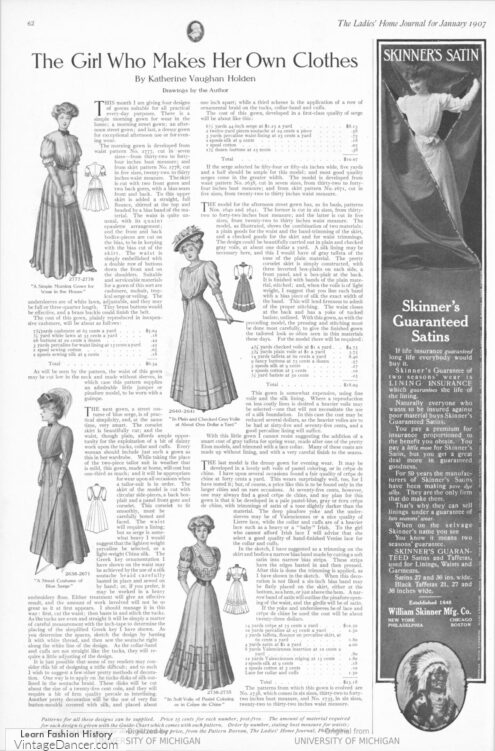
1906 A home sewing plan for a young woman. Cost $6-23 per dress on fabric and trim
1918 – Wife to Manual Laborer:
- Hat – 1 summer, 1 felt hat purchased every 1-2 years.
- Skirts – 1
- Cotton skirt – purchased every 2 years.
- Blouse – 3 cotton, 1 fancy.
- Dress – 2 cotton housedresses (handmade), 1 cotton summer dress, wool dress (1 purchased/made every 2 years).
- Suits – 1 wool purchased every 2 years.
- Petticoats – 1 cotton, 1 fancy (satin or another cotton).
- Shoes – 1 low heel, 1 high heel, 1 rubber boots or shoes, budget for 3 shoe repairs a year (such as new heels).
- Gloves – 1 basic cotton, 1 fancy (not leather).
- Aprons – 1 handmade a year.
- Lingerie – 2 corsets , 2 corset covers, 2 brassieres.
- Underwear – 2 summer union suits, 1 winter union suits, 2 combination suits.
- Nightgowns – 2 cotton.
- Robe – 1.
- Stockings – 8 cotton.
- Handkerchiefs – 8.
1918 – Wife to Manual Laborer:
- Hat – 1 summer, 1 felt hat purchased every 1-2 years.
- Skirts – 1
- Cotton skirt – purchased every 2 years.
- Blouse – 3 cotton, 1 fancy.
- Dress – 2 cotton housedresses (handmade), 1 cotton summer dress, wool dress (1 purchased/made every 2 years).
- Suits – 1 wool purchased every 2 years.
- Petticoats – 1 cotton, 1 fancy (satin or another cotton).
- Shoes – 1 low heel, 1 high heel, 1 rubber boots or shoes, budget for 3 shoe repairs a year (such as new heels).
- Gloves – 1 basic cotton, 1 fancy (not leather).
- Aprons – 1 handmade a year.
- Lingerie – 2 corsets , 2 corset covers, 2 brassieres.
- Underwear – 2 summer union suits, 1 winter union suits, 2 combination suits.
- Nightgowns – 2 cotton.
- Robe – 1.
- Stockings – 8 cotton.
- Handkerchiefs – 8.
1910s Men’s Clothing Budget
Men’s clothing usually cost more than women’s, but lasted longer and was purchased less often. Men’s clothing was almost never homemade during any of the decades I looked at. Men went to a trusted tailor in town or from a traveling salesmen for a custom made suit. Suits usually came with an extra pair of trousers and 1 or two vests.
Shirts, collars, underwear and neckties were purchased more often from ready-made shops.
Shoes and hats were purchased at specialty stores although the all in one men’s shop was becoming more commonplace. Hats and shoes were often re-shaped or repaired several times a year.
For lower class men, second hand shops afford them a suit jacket, vest and trousers that did not match.
Work-wear clothing was more affordable to buy new but was also worn to threads.
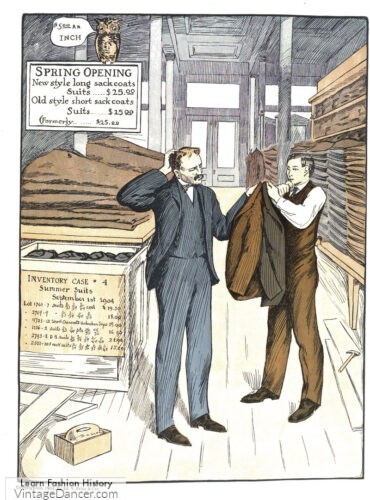
1904 bargain shopping for suits for $15 -25. Last year’s designs were sold for less.
1918 Man – Manual Laborer:
- Hats – 1 straw, 1 felt (purchased every 2 years), 1 cap.
- Overcoat – 1 purchased every 4 years.
- Suits – 1 summer suit (purchased every 3 years), 1 winter suit (purchased every 3 years).
- Sweater – 1 purchased every 4 years.
- Union Suits – 5.
- Gloves – 1 work, 6 cotton.
- Work Trousers or Overalls – 2 purchased yearly.
- Shirts – 1 dress shirts, 5 work shirts, 6 shirt collars.
- Nightshirts – 2.
- Socks – 12 socks, 2 sock garters.
- Shoes – 1 dress shoe (purchased every 2 years) , 2 work shoes/boots, 1 rubber boots (replaced every 2 years), extra budget for shoe repair (soles and heels).
- Ties – 2.
- Handkerchiefs – 8.
- Belt – 1 every 3 years, 1 suspenders.
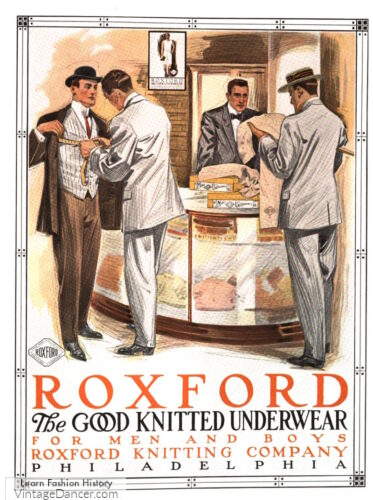
1919 Middle Class Man – Spent $112 a year on the following:
- Suits – 1.
- Coats – 1 purchased every 3 years.
- Work Trousers – 1.
- Sweaters – 1 purchased every 2 years.
- Shirts – 2.
- Work Shirts – 3.
- Overalls – 2.
- Shoes – 2.
- Socks – 8.
- Union Suits – 3.
- Night Shirts – 2.
- Collars – 4.
- Ties – 3.
- Hats – 1 felt hat (purchased every 2 years), 1 straw hat, 1 cap.
- Gloves – 1-2 pairs.
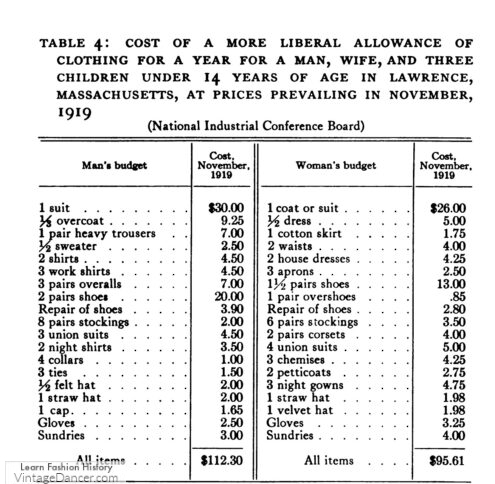
1919 man and woman clothing, middle-working class
1919 Middle Class Man’s Wife – Spent $95 a year on the following:
- Coats – 1 coat or suit.
- Dresses – 1 nice dress, 2 cotton dresses.
- Skirts – 1 cotton skirt.
- Blouses – 2.
- Aprons – 3.
- Shoes – 1-2 pairs, 1 pair overshoes.
- Stockings – 6.
- Lingerie – 2 corsets.
- Underwear – 4 union suits, 3 chemise, 2 petticoats.
- Sleepwear – 3 nightgowns.
- Hats – 1 velvet, 1 straw.
- Gloves – 2-4 pairs.
A well dressed wealthy man had multiple suits and outfits for any kind of event, outing or home wear. There were many rules for what to wear and what colors to coordinate for morning, afternoon, evening and outing (casual) dress. Two examples are:
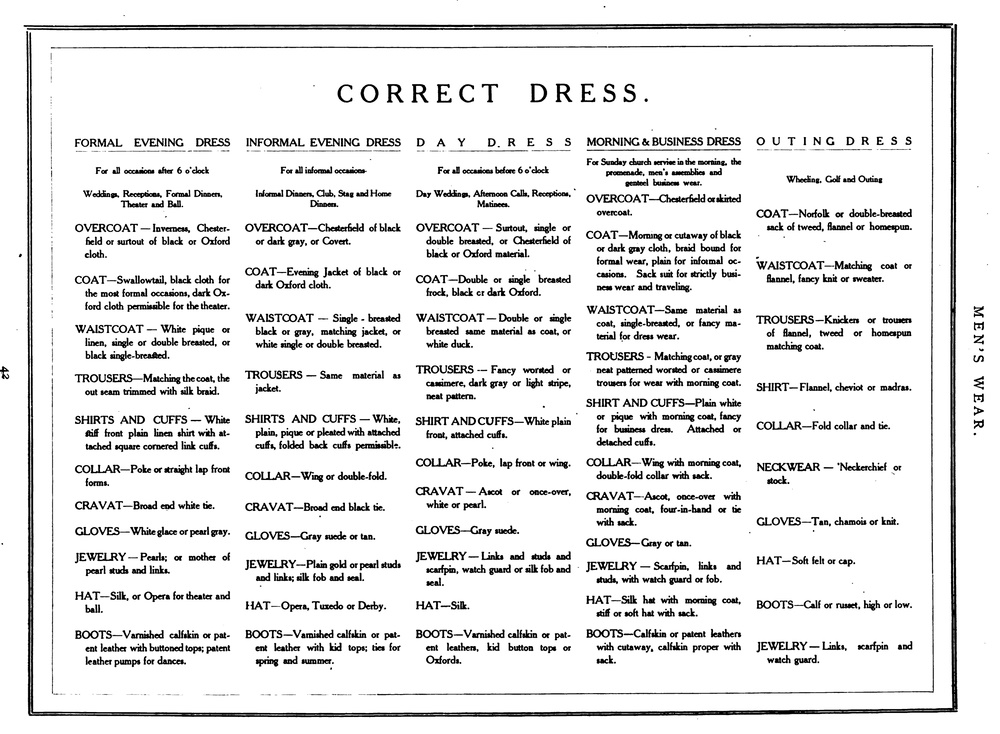
1905 men’s clothing plan form Men’s Wear magazine
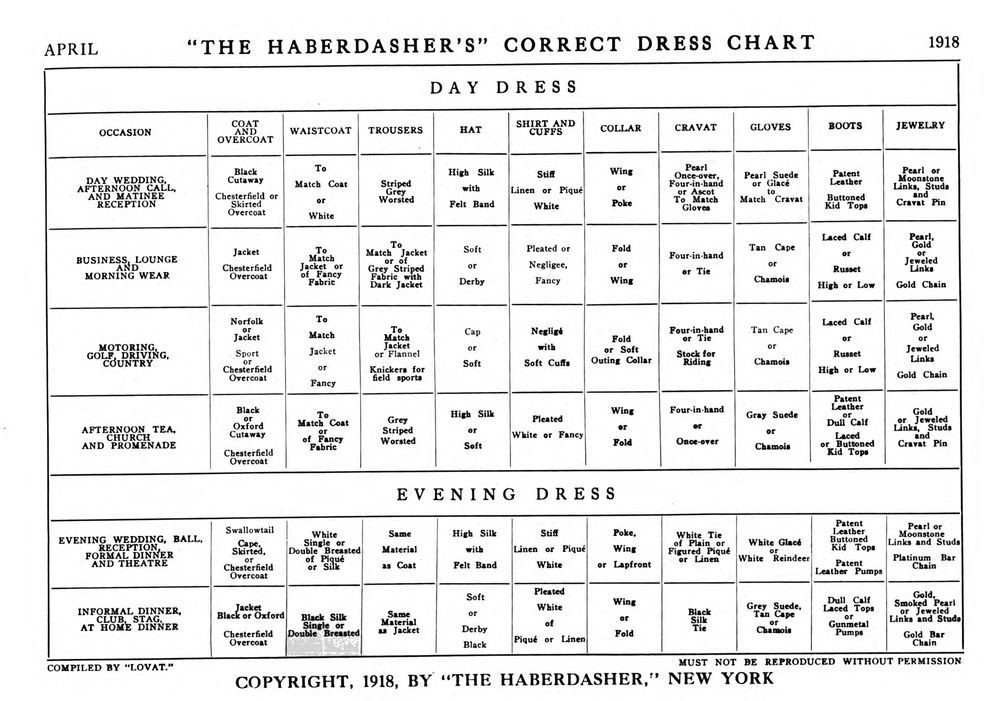
1918 men’s clothing plan from the Haberdasher
What questions do you have about the clothing women and men wore in the 1900s and 1910s?
Debbie Sessions has been teaching fashion history and helping people dress for vintage themed events since 2009. She has turned a hobby into VintageDancer.com with hundreds of well researched articles and hand picked links to vintage inspired clothing online. She aims to make dressing accurately (or not) an affordable option for all. Oh, and she dances too.
